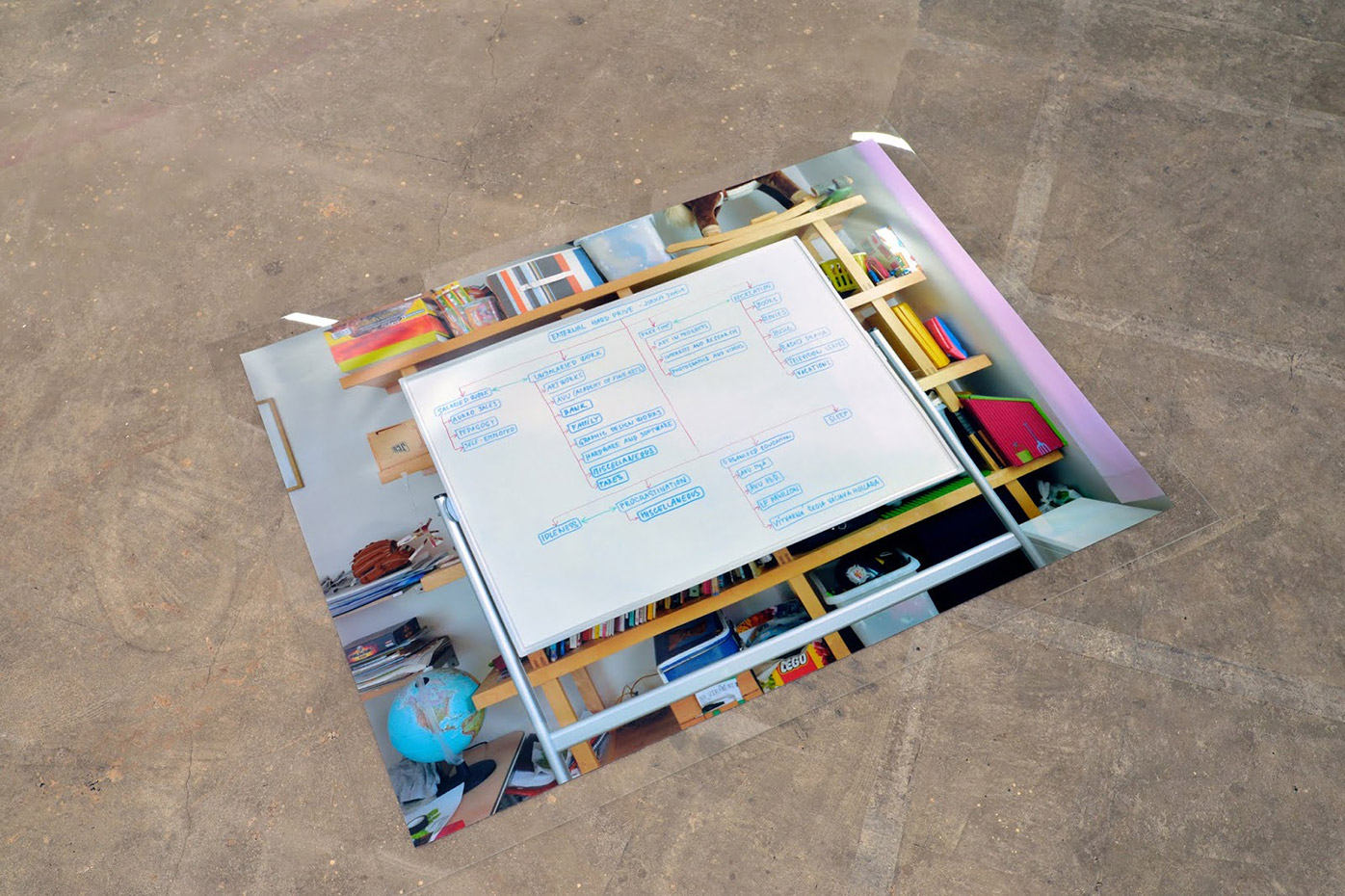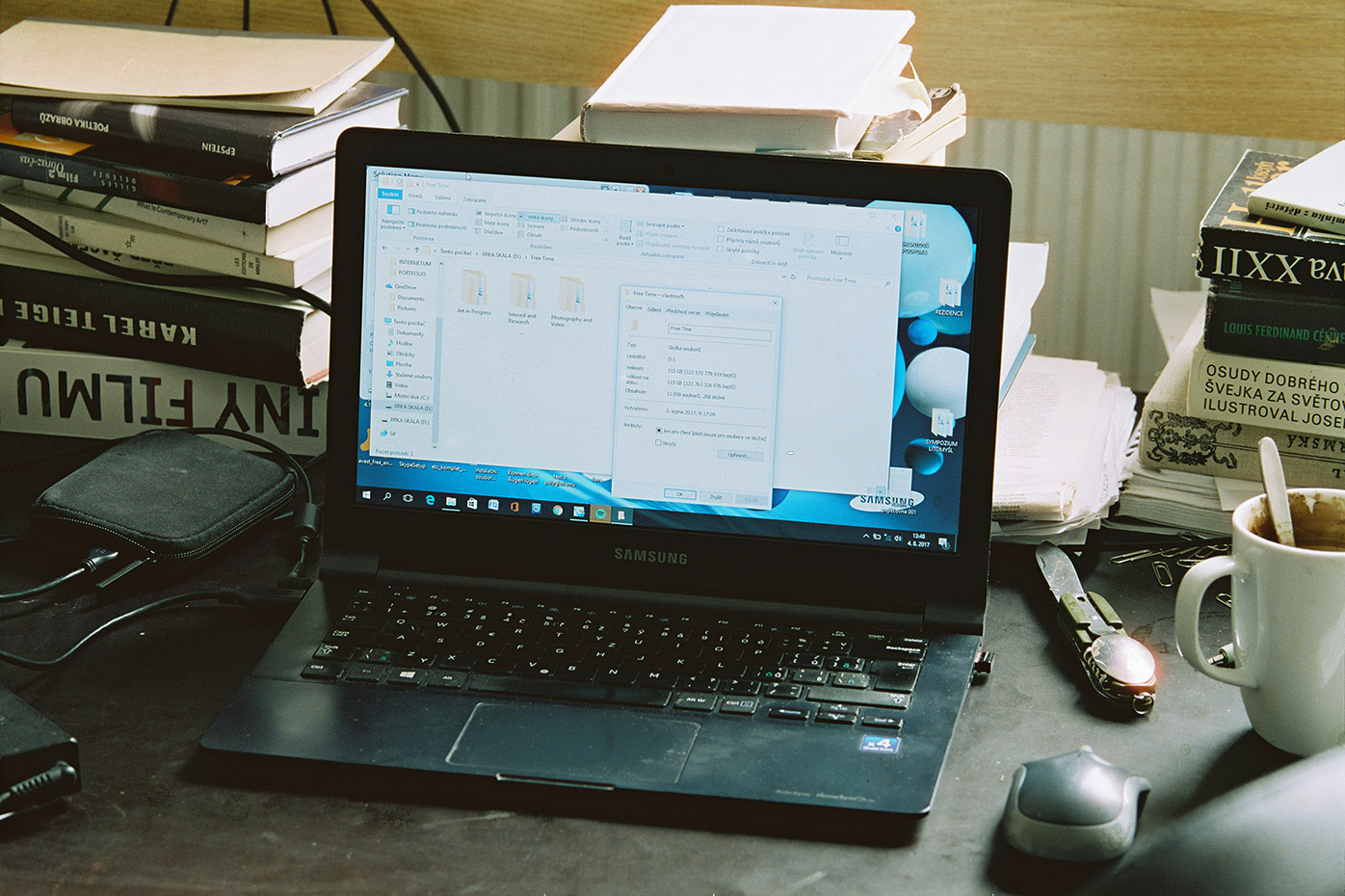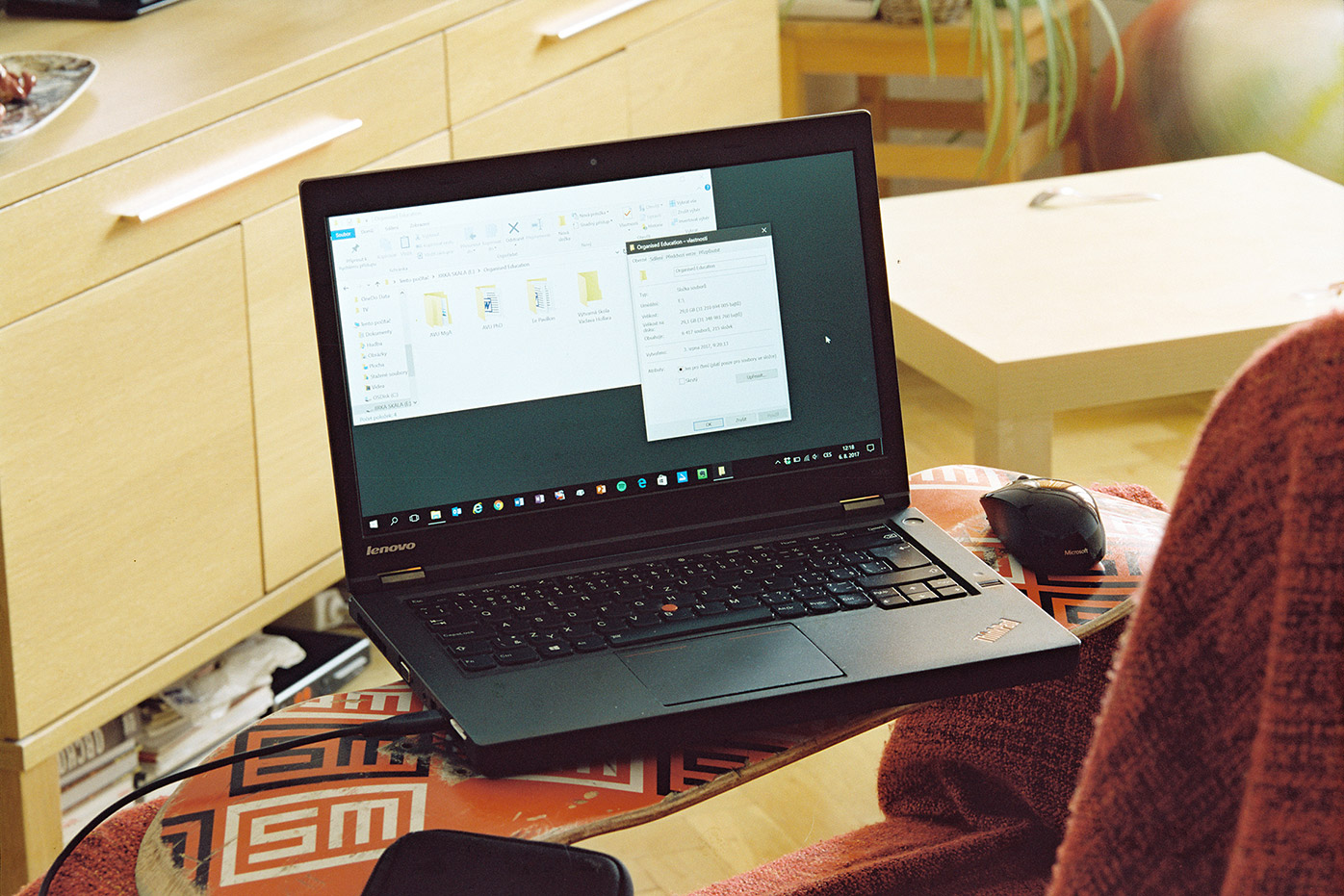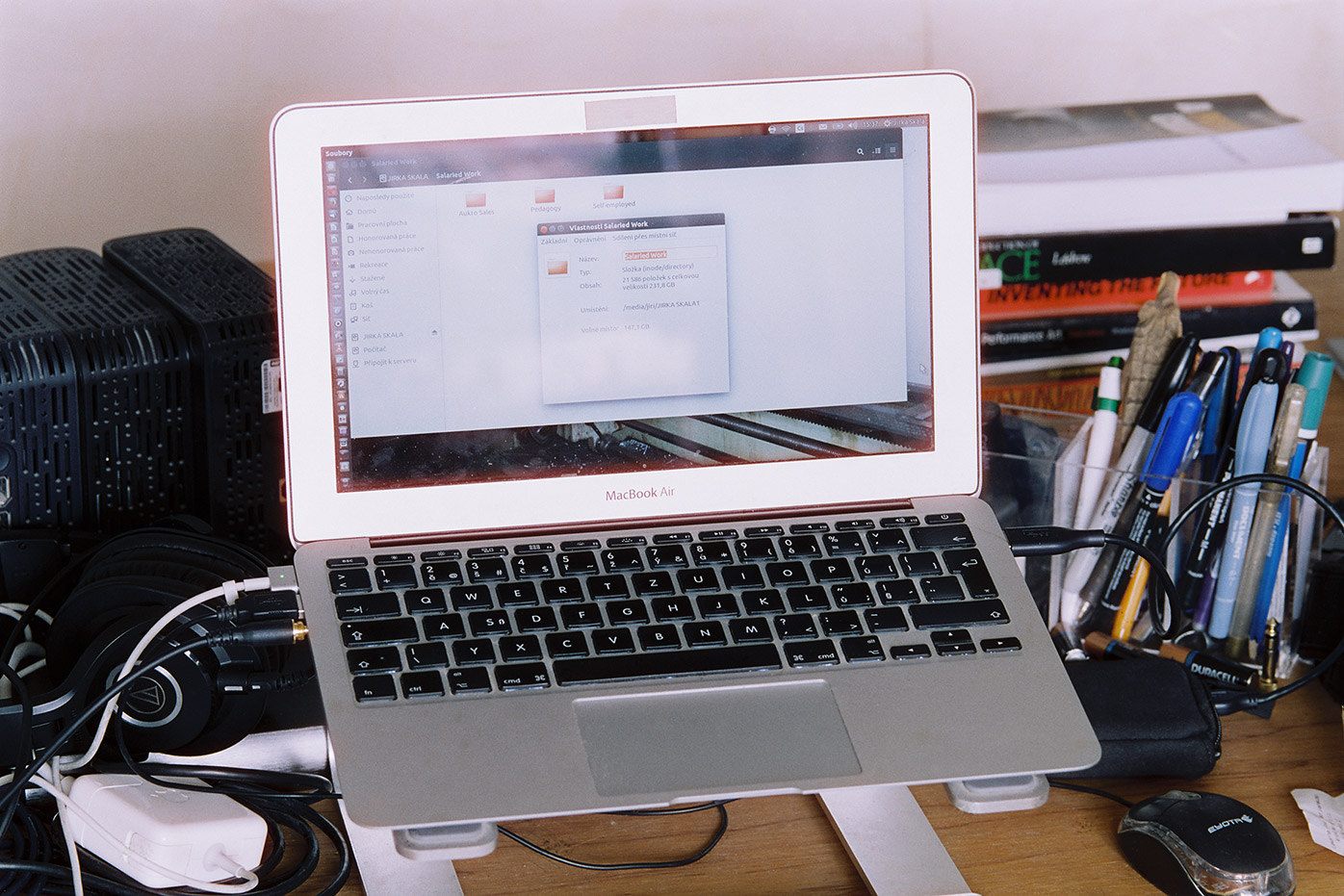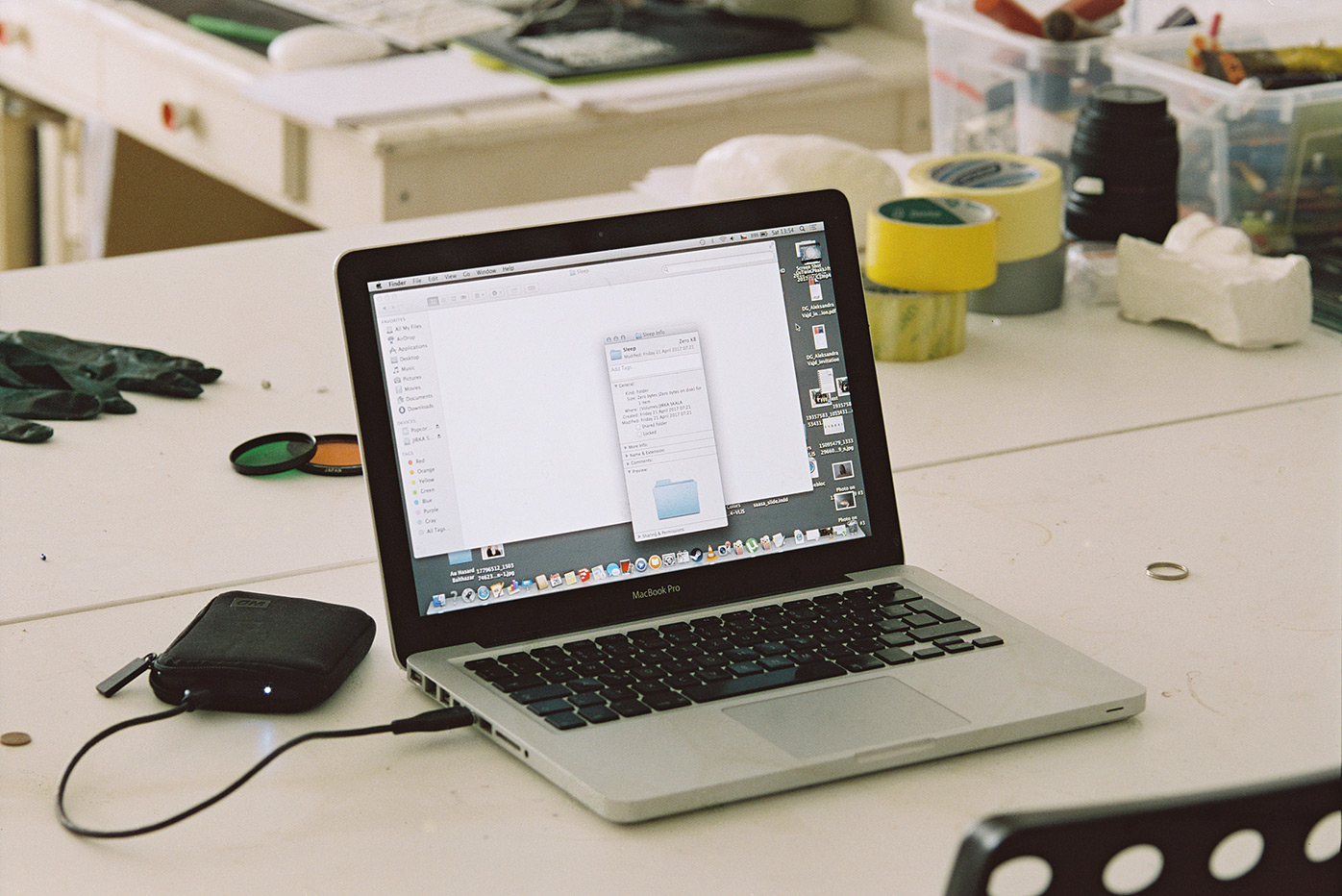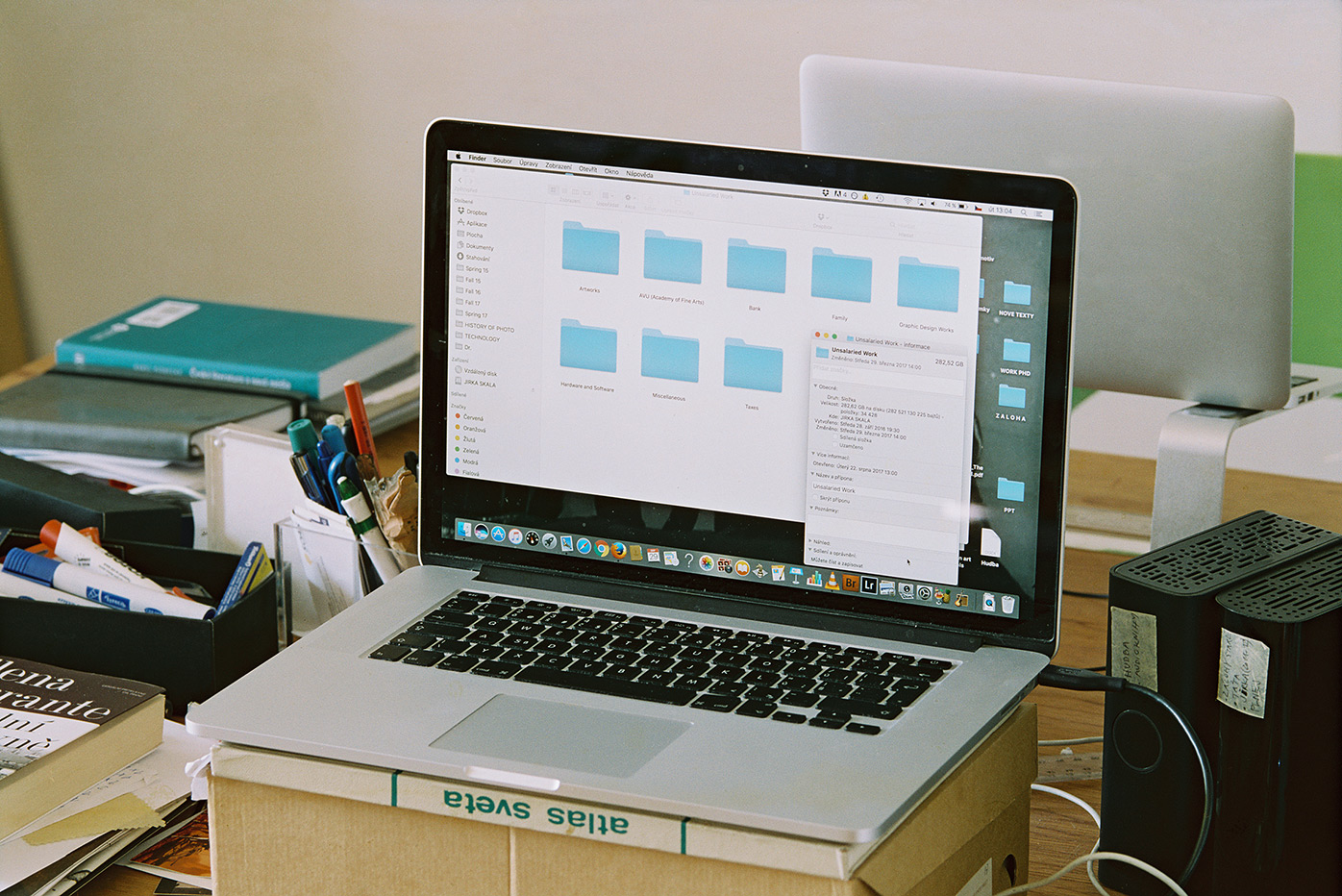Art Practice and Other Activities
Photography from the Art Practice and Other Activities series, 2017, Lambda print, 120x90, view from the exhibition Happy End, organized by Lítost Gallery, Svit Galley, 2018, photo: Lítost Gallery
Hard drives
I hold a plastic object in
my hands every day. It is a small prism, more flat than high. It is around 13
centimeters long, 9 cm wide and 2 cm high. I carry it from home to work and
back regularly. I connect it to and disconnect it from different computers all
the time, and therefore I touch it constantly. I have a very specific and
physical relation to it.
It is an external memory
drive. In my artistic practice I have already focused on this technology once,
in the video installation entitled The
Involuntary Archivist. It was created seven years
ago in collaboration with Zbyněk Baladrán and the hard disk theme plays a
central role in it. Since then, I have always wanted
to return to this theme to answer the following questions:Can we unfetter hard disks from their function to store and archive data for
us? Can they be more than just working tools? Can
hard disks mirror our concepts of work, its division into salaried and
unsalaried activity, our need for free time and recreation and the need for
sleep and idleness?
![]()
Free Time (115 Gb and 11058 items), 2017, Lambda print, 60x40 cm
Hard drives and archiving of work activities
I do not only have one hard
disk, I actually own three of them though I use only one, the other two serve
as backup. I keep the first one at home and the second I keep at work. All this
for two reasons: in case someone breaks into my apartment or workplace and
steals it or in case of hard disk failure, be it because of accidental damage
or just deterioration.
Still, I have lost a
relatively large amount of data over the past 20 years. Some was work I then had to redo, some was
data of sentimental value such as family photos. It has happened with CDs, with
their re-writable versions, with DVDs, but also with hard drives. That is why I
keep several hard disks in a number of places.
Perhaps all computer users
have at some point lost some of their data. For this reason, there exists the
possibility to store digital data on remote servers owned by different
multinational corporations. I use several cloud services like Google Documents,
Google Photos, Flickr, or Vimeo myself, but only to a limited extent. I do not
have everything stored there. Which means I do not have to pay for it. I have
never exceeded the free data storage limit and don’t think I ever will. I
prefer the way I store data myself. In twenty years of using computers and
external drives, I have come up with my own way of archiving. Therefore, it is
very difficult for me to accept the predefined interface of these cloud
services and to put my information there.
I started working on my archiving system 12 years ago and my
interest during the first 10 years was
focused solely on work. Maybe that is why I chose the most primitive solution.
First of all, I sorted the data by years. I created a folder with an assigned
year. Second, I started putting all the work done for the relevant time period
in the corresponding folder. Third, I marked the particular archived items in a
color to differentiate the work being done. Red was for art, orange for graphic
works, purple marked the activities associated with Etc gallery and so on.
After a few years, I
believed I had perfected a method of data storing and archiving.
![]()
Idleness (0 kb and 0 items), 2017, Lambda print, 60x40 cm
Hard drives and the archiving of human activities
But this stable working
relationship began to change. Especially in 2012, when a number of artists and
art critics, Jirka Ptáček, Pavel Sterec and Tereza Stejskalová, launched the
campaign Zero Wage.
Zero Wage focused on a specific
problem: many artists in state or non-profit institutions do not get paid for
their artwork, so they have had to subsidize most of their artistic activities
from other sources.
This campaign for
introducing an artist’s fee was supported by a relatively large number of
active artists, especially from the younger generation. But an even larger part
of the artistic community ignored this initiative or positioned themselves
against it.
This attempt to change the
system in which Czech artists realize their activities has changed many
people's view of artistic work. And this, in turn, has become the subject of my
work over the past few years.
![]()
Organised Education (29 Gb and 6417 items), 2017, Lambda print, 60x40 cm
The fundamental problem
when discussing artistic work is the excessive subjectivity of feelings. On the
one hand, it is based on the long-term frustration over the functioning of the
Czech art scene and, on the other hand, on the somewhat stereotypical idea of
artistic creation as an autonomous act outside what is usually referred to as
work.
Above all, this
subjectivity has always made me quite angry. That's why I decided to find a way
to relate this discussion to a physical reality, to try to limit the influence
of dominant social ideologies on our thinking about art practice and its
financial evaluation.
To solve this personal
challenge, I turned to my external drives. The data stored on them is just as
relevant a source of artistic work as the “hard” production of any artist.
That's why I can use them for my internal research. You just need to divide the
"artwork" folder into salaried and unsalaried work, then quantify and
analyze everything. In this way, I will be able to tell everyone how much time
I devoted to my art practice and how much time I spend on other,
non-renumerated activities such as those that support the emergence of new art
projects.
I started to browse most of
the data on my external drives, and gradually I came to the conclusion that the
information contained in the artwork folder is inadequate and that I will have
to reclassify a lot of things. Most of my artistic activities exist on the very
fluid boundaries between unsalaried work, private life and leisure-time
activities. This has proven to be a big problem because all the data concerning
my personal relationships and interests are arranged very randomly, everything
stored in a number of folders with the original names of photos, pdfs, movies,
and music.
![]()
Procrastination (242 Mb and 102 items), 2017, Lambda print, 60x40 cm
The moment I realized this
fact, it occurred to me that my external drive and my computer were not just
the means of production. They are above all devices in which silicon wires
contain the records of my private life, they are pretty much stuffed with them.
If I want to analyze
salaried and unsalaried work in the fine arts, I will have to rearrange all of
my data.
So, I bought a Western
Digital storage disk with 1 TB of data, formatted it and moved all the data
there and started organizing. I deleted some folders and divided others.
Numerous touches of the keyboard and the mouse began to create a new type of
archive.
Its basic structure
consists of eight folders that appear on the computer screen when an external
drive is attached: Salaried Work, Idleness, Unsalaried Work, Organized
Education, Procrastination, Recreation, Sleep, and Free Time. Two of the eight
folders are empty. I have them on the hard disk to remind me of human
activities that have not been fully affected by the cyber revolution and that
make us fully fledged human beings, namely Idleness and Sleep. The remaining
six are full of data and information. All together, they refer to the most
important human activities. Part of these work in pairs, such as salaried and
unsalaried work, free time and recreation, idleness and procrastination. Others
work independently, such as organized education and sleep. These do not require
a partner, a social counterpart.
![]()
Recreation (167,1 Gb and 4364 items), 2017, Lambda print, 60x40 cm
The division of the folders
and their naming are based on economics, political philosophy and the sociology
of space and time. In the case of salaried and unsalaried work, I was inspired
by Guy Standing, a British economist dealing with the terms of work and labor.
He carefully analyzes and outlines them in his books. Labor – that is, salaried
work—is not only connected to receiving a wage but is above all a social and
economic concept that dominated the global political space during the 19th
century. While work—that is, unsalaried work – is, according to Standing, a
human activity carried out without the claim for wages, in a domestic,
community or public sphere. In his argumentation he refers to Hannah Arendt's
book The Human Condition and compares
unsalaried work to the Ancient Greek schole, a term translatable as
self-education.
Although I appreciate the
arguments of Standing and Arendt, I cannot agree with them completely, they are
too romantic and simplistic. They do not fully accept the long-term tension
between salaried and unsalaried work that manifests itself in historical
prejudices and chauvinism. That is why, I have, under the influence of modern
feminist theories dealing with the unpaid work of women in the home, further
divided the unsalaried work folder into 2 subfolders - a free time folder and a
folder with unsalaried work. The book The Second Shift by Arlie
Hochschild and Anne Machung served, in this case, as inspiration.
In the case of the Idleness
folder, I was inspired by the writings of Paul Lafargue's The Right to Be
Lazy, Laziness as the Truth of Mankind by Kazimir Malevich and,
above all, Praise of Laziness by Mladen Stilinović. The origin and
designation of other folders (Recreation, Procrastination, Sleep, and Organized
Education) are not based on specific sources but are derived from my own
experience and long-term interest in various activities.
![]()
Salared Work (231,8 Gb and 21586 items), 2017, Lambda print, 60x40 cm
Hard drives and artwork
The biggest problems arose
with the Artwork folder. I have been working on it for the last ten years and I
did not want to give up on it. It was not possible to simply split it up into 2
- one folder with salaried work and one with unsalaried work. This
classification would not make sense in this case and I would not learn anything
from it.
After a long hesitation I
reorganized the artwork folder thus - work for which I received a financial
reward can be found in the Salaried Work folder. Work done without the claim to
wage is stored in Unsalaried Work. And I have moved Artwork in the preparation
and creation stages to the Free Time folder under the Art in Progress label.
In this case, I was
inspired by the idea of autonomy espoused by artists and theoreticians from the
1960s. However, unlike them, I have come to the conclusion that the idea of
temporal and spatial autonomy can only be related to the preparation and
realization of an artwork. But at the time of its incorporation into the
society of people and objects, we have to think of it in terms of salaried or
unsalaried work.
During the transfer of
artwork to the folders of salaried and unsalaried work, I had to admit that the
vast majority of my artistic activities falls under unsalaried work. The
difference between the two is nearly double. In the first one, 21,587 files are
stored, taking up 232 GB, and in the other I have 47,551 files occupying 270
GB. During the final evaluation, I
focused on the number of items. For a simple reason. In the Salaried Work
folder, several videos are stored, accounting for up to 40 percent of the data.
Unlike the Unsalaried Work, where I have mostly lyrics, pdfs, and low quality
photos.
![]()
Sleep (0 kb and 0 items), 2017, Lambda print, 60x40 cm
The Unsalaried Work folder
is the largest one. Its content is divided into eight subfolders, which refer
to the most diverse human activities in the context of unsalaried work (free
time activities, self-presentation, cooperation, concern and care).
There is an AVU (Academy of
Fine Arts) subfolder. This concerns non-occupational activities at the Academy
(photographic documentation of atelier activities and taking care of regular
social media output). A three-year term in the Academic Senate and a failed
attempt to represent the Academy in the Council of Universities also falls into
this category.
There are sub-folders
dedicated to managing bank accounts and paying taxes. As well as one containing
graphic work done without renumeration.
Finally there are
subfolders for Family and Miscellaneous. In these folders you can find
information about parenting and helping friends and acquaintances. These
activities occupy a very small part of the hard disk. These are mostly jobs
that are invisible to digital technology, they take place outside of them.
![]()
Unsalared Work (282,52 Gb and 34428 items), 2017, Lambda print, 60x40 cm

